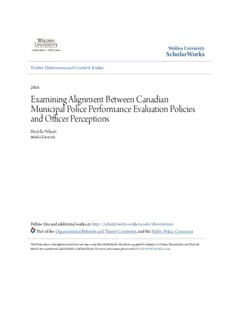
Examining Alignment Between Canadian Municipal Police Performance Evaluation Policies and ... PDF
Preview Examining Alignment Between Canadian Municipal Police Performance Evaluation Policies and ...
Walden University ScholarWorks Walden Dissertations and Doctoral Studies Walden Dissertations and Doctoral Studies Collection 2016 Examining Alignment Between Canadian Municipal Police Performance Evaluation Policies and Officer Perceptions Birdella Wilson Walden University Follow this and additional works at:https://scholarworks.waldenu.edu/dissertations Part of theOrganizational Behavior and Theory Commons, and thePublic Policy Commons This Dissertation is brought to you for free and open access by the Walden Dissertations and Doctoral Studies Collection at ScholarWorks. It has been accepted for inclusion in Walden Dissertations and Doctoral Studies by an authorized administrator of ScholarWorks. For more information, please [email protected]. Walden University College of Social and Behavioral Sciences This is to certify that the doctoral dissertation by Birdella Wilson has been found to be complete and satisfactory in all respects, and that any and all revisions required by the review committee have been made. Review Committee Dr. Matthew Jones, Committee Chairperson, Public Policy and Administration Faculty Dr. Richard Worch, Committee Member, Public Policy and Administration Faculty Dr. Christopher Jones, University Reviewer, Public Policy and Administration Faculty Chief Academic Officer Eric Riedel, Ph.D. Walden University 2016 Abstract Examining Alignment Between Canadian Municipal Police Performance Evaluation Policies and Officer Perceptions by Birdella Lorraine Wilson M.S.W., M.T.S., [Wilfrid Laurier University], 1992, 2002 B.A., B.S.W. McMaster University, 1990 Dissertation Submitted in Partial Fulfillment of the Requirements for the Degree of Doctor of Philosophy Public Policy and Administration Walden University August 2016 Abstract A lack of alignment between police performance evaluation policy purposes and officer performance evaluation perceptions has implications for the organizations’ resource management, officer morale, and public safety. A literature review points towards a gap existing between policy purpose statements and employee perceptions. The purpose of this study was to investigate the relationship between the policy purposes of police performance evaluations and the officers’ perceptions of those evaluation experiences in 4 Ontario municipal police services. DiMaggio and Powell’s (1983) Institutional theory was the foundation for this study. Data for this study were collected from 4 police services in Ontario, Canada. The data consisted of police performance evaluation policies and in-person interviews with 12 officers. Data were inductively coded, and then the coded data were subjected to content analysis. Three policy purpose themes and 13 officer perception themes emerged that indicate that: 1) there seems to be a lack of alignment between the policy purpose theme of assessing work performance and eight of the perception themes; 2) officers perceived performance evaluations as negatively impacting their morale: and, 3) healthy relationships with supervisors were more useful to officers than performance evaluations in terms of performance and career outcomes and progression. Consistent with Institutional theory, officers perceived performance evaluations to be necessary even with limited utility. The positive social change implications stemming from this study include recommendations to police executives to consider alternative processes in tandem with performance evaluations to improve morale, in turn creating better opportunities for improved public and officer safety. Examining Alignment Between Canadian Municipal Police Performance Evaluation Policies and Officer Perceptions. by Birdella Lorraine Wilson M.S.W., M.T.S., [Wilfrid Laurier University], 1992, 2002 B.A., B.S.W. McMaster University, 1990 Dissertation Submitted in Partial Fulfillment of the Requirements for the Degree of Doctor of Philosophy Public Policy and Administration Walden University April 2016 Dedication For those who work full-time, take care of their families and still make time for education. Acknowledgments I thank Peel Regional Police who has funded this degree as part of their commitment to the development of employees. Without their financial support I would not be writing this. I also acknowledge my parents, Lorna and Fred Wilson who fostered a love of learning and supported my education, something that they did not have. Dr. Jones, my Research Chair and Dr. Worch have been critical to me finishing this degree and are excellent in providing feedback and being both accessible and supportive. Finally, many thanks to Joseph Paolini, my sweetheart, who for the past many years has been supportive while giving up big parts of our life together as I worked on this degree. Table of Contents List of Tables .......................................................................................................................v Chapter 1: Introduction to the Study ....................................................................................1 Introduction ....................................................................................................................1 Background of the Study ...............................................................................................1 Problem Statement .........................................................................................................3 Purpose of the Study ......................................................................................................3 Research Question .........................................................................................................4 Theoretical Foundation ..................................................................................................4 Conceptual Framework ..................................................................................................6 Nature of the Study ........................................................................................................8 Definition of Terms........................................................................................................9 Assumptions .................................................................................................................10 Scope ..........................................................................................................................11 Delimitations ................................................................................................................11 Limitations ...................................................................................................................12 Significance..................................................................................................................13 Summary ......................................................................................................................14 Chapter 2: Literature Review .............................................................................................16 Introduction ..................................................................................................................16 Literature Search Strategy............................................................................................17 i Theoretical Foundation ................................................................................................19 Police Organizations’ Unique Societal Position ..........................................................27 Performance Evaluations .............................................................................................29 Transparency and Accountability ................................................................................31 Alignment ....................................................................................................................32 Summary ......................................................................................................................34 Chapter 3: Research Method ..............................................................................................35 Introduction ..................................................................................................................35 Research Design and Rationale ...................................................................................36 Role of the Researcher .................................................................................................37 Methodological Approach ...........................................................................................38 Participant Selection Logic ................................................................................... 38 Determining the Sample ....................................................................................... 39 Instrumentation ..................................................................................................... 42 Procedures for Recruitment, Participation, and Data Collection .......................... 43 Data Analysis ........................................................................................................ 45 Issues of Trustworthiness .............................................................................................46 Ethical Procedures ................................................................................................ 53 Summary ......................................................................................................................54 Chapter 4: Results .............................................................................................................55 Introduction ..................................................................................................................55 Setting ..........................................................................................................................55 ii Demographics ..............................................................................................................56 Data Collection ............................................................................................................57 Data Analysis ...............................................................................................................57 Evidence of Trustworthiness........................................................................................59 Results ..........................................................................................................................63 Interview Themes.................................................................................................. 63 Policy Themes ....................................................................................................... 95 Discussion of the Relationship between Officer Perception Themes and Policy Themes ........................................................................................... 96 Discussion of Officer Perception Themes by Highest Subcategory Response Percentages in Relation to Policy Purpose Themes................ 112 Discussion of Officer Perception Themes by Second Highest Subcategory Response Percentages in Relation to Policy Purpose Themes................ 115 Discussion of Officer Perception Themes by Third Highest Subcategory Response Percentages in Relation to Policy Purpose Themes................ 118 Discussion of Officer Perception Themes by Fourth Highest Subcategory Response Percentages in Relation to Policy Purpose Themes................ 120 Discussion of Response Frequency Percentages by Perception Theme and Policy Purpose Themes/Nonalignment ................................................... 120 Discussion of the Importance of Discrepant Data .............................................. 121 Discussion of Results in Relation to Institutional Theory .................................. 125 Summary ....................................................................................................................126 iii
Description: